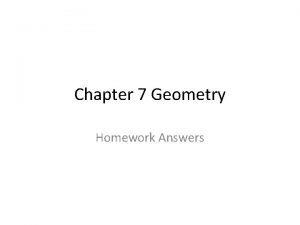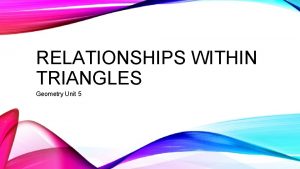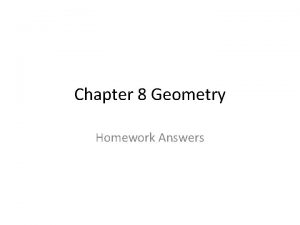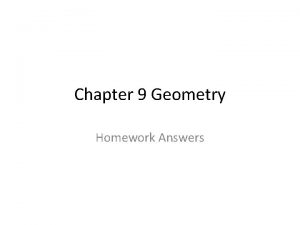Chapter 2 Geometry Homework Answers Sec 2 1









- Slides: 9

Chapter 2 Geometry Homework Answers

Sec 2. 1 1) “All rocks sink. ” Stony needs to find one rock that will not sink. 2) If two angles are formed by drawing a ray from a line, then their measures add up to 180°. 3) 10000, 100000, …. Each term is 10 times the previous term. 4) 5/6, 1, …. (Written with the common denominator of 6, the pattern becomes 1/6, 2/6, 3/6, 4/6, 5/6, 6/6, …) 5) -17, -21 6) 28, 36 7) 21, 34 8) 49, 64 9) -10, -24 10) 64, 128 11 -16) See diagrams. 17) 1, 4, 7, 10, 13 18) 19) 21) 22) 15, 21, 28, 36, 45 Answers will vary. Conjecture is false; 14² =196 but 41² =1681 23 -25) See diagrams. 29) Collinear 30) Isosceles 31) Protractor 32) Radius 33) Diagonal 34) Dodecagon 35) Parallel 36) Regular 37) 90° 38) Perpendicular 39 -42) See diagrams.

Sec 2. 2 1) 2) 3) 4) 5) 6) 7) 8) 9) 11) Inductive; deductive m ‹ B= 65°; deductive or inductive Inductive DG= 258 cm; deductive 180° ; sum of the five angles is 180° ; inductive LNDA is a parallelogram; deductive 3; 10; 7 Just over 45°; if m > 90°, then ½ m > 45° If 11, 111 is multiplied by itself, then the product will be 123, 454, 321. But when 1, 111, 111 is multiplied by itself, the digits can’t go up to 10. So 1, 111, 111 x 1, 111, 111=1, 234, 567, 900, 987, 654, 321. The pattern cannot be generalized because once the river is straight, it cannot get any shorter. 12) 900, 1080 13) 75, 91 14) 4/5, 12 15 -18) See diagrams. 20) L 21) M 22) A 23) B 24) E 25) C 26) G 27) D 28) H 29) I

Sec 2. 3 1) 2) 3) 4) 5) 6) 6 n-3; 117 -3 n+4; -56 8 n-12; 148 16, 24, 32, 40, 48; 8 n; 1600 1, 9, 13, 17, 21; 4 n-3; 797 13, 17, 21, 25; 4 n+1; 801 11, 14, 17, 20; 3 n+2; 602 7) 1, 2, 3, 4; n-2; 33 9) Slope: (9 -6)/ (4 -2)= 3/2; y-intercept: (0, 3); y=1. 5 x+3 10 -11) See diagrams. 17) 48°; 17°; 62°; m ‹ CPB

Sec 2. 4 1) 2) 3) 4) 5) 6) 7) 8) 9) 10) 4, 6, 8, 10; 2 n; 70 n+1, 36 n-3, because you can draw a diagonal from one vertex to all the other vertices 11) except three of them, the two adjacent 12) vertices and the vertex itself; 32 13) See diagram. n(n-3)/2, 560 See diagram. n(n-1)/2, 595 14) See diagram. n(n-1)/2, 595 15) See proof. 16) Use n(n-1)/2 to get 780 direct lines. Use a 17) central hub with a line to each house to get 40 lines. 18) Use points for the 10 teams and segments connecting them to represent four games played between them. So, use 4 x [n(n 19) 10/2] to get 180 games played. If n(n-1)/2=66, then n(n-1)=132. What two consecutive numbers multiply to equal 132? 12 times 11. Thus, there were 12 people at the party. True False; an isosceles right triangle has two sides congruent. False; see diagram. False; they are parallel. True False; a rectangle is a parallelogram with all of its angles congruent. False; a diagonal is a segment in a polygon connecting any two nonconsecutive vertices. True

Sec 2. 5 1) 2) 3) 4) 5) 6) 7) 8) 9) 10) 11) a = 60, b = 120, c = 120 18) a = 90, b = 90, c = 50 19) a = 77, b = 52, c = 77, d = 51 22) a = 60, b = c = 120, d = f = 115, e = 65, g = i = 23) 125, h = 55 a = 90, b = 163, c = 17, d = 110, e = 70 24) The measures of the linear pair of angles 25) add up to 170, not 180. 26) The best angles at which he should cut 27) measure 45. Greatest: 120. Smallest: 60. The converse is not true. each must be a right angle Let the measures of the congruent angles be x. They are supplementary, so x + x = 180, 2 x • = 180, x = 90. Thus each angle is a right angle. See description. 22. 5 22, 26, 30; 4 n + 6; 806 handshake problem: n(n-1)/2; 80(79)/2 = 3160 pieces of string 3160 intersections n(n-2)/2 yields 760 handshakes. 21; 252 n(n-3)/2 = 560; there are 35 vertices. Answers in degrees unless otherwise labeled.

Sec 2. 6 1) 2) 3) 4) 5) 6) 7) 9) 10) 11) 14) 15) 19) 63 90 no 57 yes 113 a = d = 64, b = c = 116, e = g = i = j = k = 108, f = h = s =72, m = 105, n = 79, p = 90, q = 116, t = 119 56 + 114 = 170 ≠ 180. Thus, the lines marked as parallel cannot really be parallel. Alternate interior angles measure 55, but 55 + 45 ≠ 180. The incoming and outgoing angles measure 45. See diagram. 18 cm • 39 3486 Answers in degrees unless otherwise labeled.

Using Your Algebra Skills 2: Slope 1) 2) 3) 4) 5) 6) 7) 8) -2 -12/13 97/46 ≈ 2. 1 y = 23 x=4 Any point of the form (3 p, -4 p). ≈ 66. 7 mi/hr At 6 m/sec Skater 1 is 4 m/sec faster than Skater 2 at 2 m/sec.

Ch 2 Review 1) 4) 5) 6) 7) 8) 9) 10) 12) 13) 14) 15) 16) 17) poor inductive reasoning, but Diana was probably just being funny 91, 105 V, 16 19, -30 S, 36 2, 5, 10, 17, 26, 37 1, 2, 4, 8, 16, 32 See diagram. -3 n + 5; -55 n²; 400 n(n - 1)/2; 190 n(n + 1)/2; 210 30² = 900 (30)(31) = 930 18) 19) 21) 22) 23) 24) 25) 26) n², 30² = 900 n(n +1)/2, (100)(101)/2 = 5050 n(n – 1)/2 = 741. Therefore, n = 39. n(n – 1)/2, 28(27)/2 = 378 n(n – 1)/2 = 2926. Therefore, n = 77. n – 2, 54 – 2 = 52 n – 2 = 54. Therefore, n = 56. a = 38, b = 38, c = 142, d = 38, e = 50, f = 65, g = 106, h = 74 – Answers for #26 in degrees
















